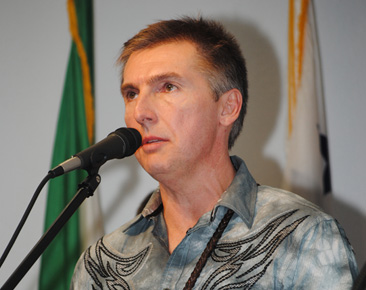
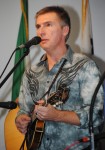 Veteran bluegrass mandolin player Alan Bibey of Grasstowne does it the old-fashioned way—and doesn’t mind telling you why.
Veteran bluegrass mandolin player Alan Bibey of Grasstowne does it the old-fashioned way—and doesn’t mind telling you why.
He took a few minutes to explain between sound check and Grasstowne’s November 29 performance in the North Brevard Shrine Center in Titusville, FL. Bibey is both relaxed and excited about the night’s performance, but part of that excitement, he says, is working with new players.
Building rapport with new personnel is a common aspect of maintaining a working band, just as it takes any co-workers some time to become friends and have stories to tell on one another, he said. It’s not all serious, as pleasant banter often revolves around Bibey, 48, having been in the business longer than some of his bandmates have been born.
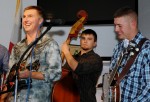 There are pleasantries, but also an undercurrent of a strict requirement to near perfection that is not only encouraged but insisted upon. These are bluegrass’s elite. Done correctly, bluegrass at this level demands a high level of instrumental ability and creativity, a strong voice capable of singing in tune, and it also needs a certain soul: the original feeling so genuinely found in legends like Bill Monroe, Earl Scruggs, Jimmy Martin and many others.
There are pleasantries, but also an undercurrent of a strict requirement to near perfection that is not only encouraged but insisted upon. These are bluegrass’s elite. Done correctly, bluegrass at this level demands a high level of instrumental ability and creativity, a strong voice capable of singing in tune, and it also needs a certain soul: the original feeling so genuinely found in legends like Bill Monroe, Earl Scruggs, Jimmy Martin and many others.
The songs may be new, but Bibey said they need to continue to show respect and reverence to its roots in rural America, and in Southern Gospel music. The hope is that tradition will continue and Bibey doesn‘t apologize for remaining close to those roots.
“I think in a way it has [continued]. With us for sure. We’re on the traditional side.”
It could go back to when Bibey’s dad took him to see Bill Monroe when he was five years old.
“I’ve told this story a bunch of times. He held me on his shoulders and I was watching from an old flatbed truck. When I got home that night I said ‘That’s what I want to do.’ He put me on the chords and I started chopping.”
The first set begins and it’s all there: the impeccable harmonies, strong breaks from each player, and the bass keeping the tempo like a freight train.
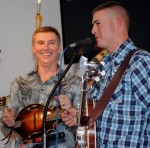
Bibey kicks into a lead, electrifying the discriminating crowd with first a combination sprinkled with rock and jazzy notes, and then finishing with a triple-time run that causes a spontaneous if muffled ‘whoop’ from a few members of the crowd.
“I think it just evolves,’’ Bibey said of his bluesy licks. “I’ve played a lot of different kinds of music but I always come back to bluegrass.’’
An original member of the New Quicksilver, IIIrd Tyme Out, and BlueRidge, in 2000 Bibey was included in Mel Bay‘s book, The Greatest Mandolin Players of the Twentieth Century. In 2007 and 2009, Alan was voted Mandolin Player Of The Year by the Society for the Preservation of Bluegrass Music in America organization in Nashville, TN. The Gibson Company had produced an Alan Bibey Signature Mandolin in 2004, reaffirming his status.
Picking is no doubt important, but the singing in bluegrass is also a key to a good overall sound, he said.
“I sing lead, tenor, baritone, really a little bit of everything. You hear a lot of different styles. For me I really try to sing in tune. I have my own studio at home so I tend to hone in on that even more because I’m always listening.”
Playing blindingly fast, another signature of some types of traditional bluegrass, takes a special type of musical connection between players, Bibey said.
“You always hear that you only as strong as your weakest link, and there’s a lot of truth to that.”
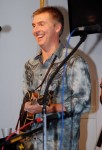 Grasstowne’s amazing successes during 2008, (SPBGMA Album Of The Year for The Road Headin’ Home) with former bandmates Steve Gulley and Phil Leadbetter, were for the most part unexpected, but the band had the advantage of established players at that time, he said.
Grasstowne’s amazing successes during 2008, (SPBGMA Album Of The Year for The Road Headin’ Home) with former bandmates Steve Gulley and Phil Leadbetter, were for the most part unexpected, but the band had the advantage of established players at that time, he said.
But it’s just a matter of time before Grasstowne climbs back up to the top.
“I loved those guys, and it was awesome but this band, as a unit, can be the best this band’s ever been. I think it’s that the bluegrass industry as a whole doesn’t know these guys as well as they did the other, but they’re phenomenal.”







